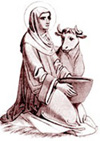
~ About St. Brigid ~
A Real Life

The life of Brigid of Ireland is cloaked in mysteries as deep as the mists of Erin itself. She has been described as a goddess, the foster-mother of Jesus, and the godmother of Irish Christianity. We know that the "historical," flesh-and-blood Brigid lived during the mid-fifth century at the same time as St. Patrick; they are said to be the "two pillars of the Irish Church."
Brigid was the founder and abbess of several dual monasteries throughout Ireland. Unlike the religious communities of later times, these places dedicated to learning and prayer were populated by both men and women. Her "home church," Kildare, was especially renowned for its art and metalwork, and a (now lost) illuminated Gospel that was praised for its beauty and intricacy.
An Active Ministry
 Despite her fame and powerful position, Brigid remained a true servant of the Beloved. She was always ready to roll up her sleeves and do whatever work was necessary — including milking the cows and tending to the chickens. Unlike the "princes of the Church" who sat in regal splendor dressed in velvets and gold brocade, the Lady of Ireland walked among her people wearing a rough-spun woolen mantle.
Despite her fame and powerful position, Brigid remained a true servant of the Beloved. She was always ready to roll up her sleeves and do whatever work was necessary — including milking the cows and tending to the chickens. Unlike the "princes of the Church" who sat in regal splendor dressed in velvets and gold brocade, the Lady of Ireland walked among her people wearing a rough-spun woolen mantle.
Seeking to minister to all those who were in need, St. Brigid was a tireless traveler and many stories are told of the miracles of healing and abundance that took place on the roads of Ireland.
It is said that throughout her life Brigid's passion and prayer was always the same: "to satisfy the poor, to banish every hardship, and to save every sorrowful soul." This was no idle wish pronounced from a lofty perch, but an embodied commitment to Christ's call.
Heaven Comes Down to Earth
 Brigid's monasteries gave food, clothing, and shelter to anyone in need; they were safe havens for poor women and children; the surrounding lands were sanctuaries for wildlife; and their herb gardens provided healing remedies for the ill. Scribes illustrated gospel texts in the morning and tended the fields in the afternoon; those who baked bread in the morning composed songs in the afternoon. These were places where prayer and work, faith and art, learning and love, songs and science combined in a radiant, holy fusion. It was almost as if the Kingdom of God had come to earth in Ireland.
Brigid's monasteries gave food, clothing, and shelter to anyone in need; they were safe havens for poor women and children; the surrounding lands were sanctuaries for wildlife; and their herb gardens provided healing remedies for the ill. Scribes illustrated gospel texts in the morning and tended the fields in the afternoon; those who baked bread in the morning composed songs in the afternoon. These were places where prayer and work, faith and art, learning and love, songs and science combined in a radiant, holy fusion. It was almost as if the Kingdom of God had come to earth in Ireland.
We celebrate Brigid as a living example of the liveliness, light, and learning of the Celtic tradition. Under her protection and authority, those who served the Beloved "kept the home fires burning," and set the country aflame with the joy and holy possibility of a life lived in the radiant light of Christ's gospel.
St. Brigid's Prayer
Brigid is celebrated for her generosity, her compassion, and her deep and powerful faith. She is also known for her playful humor, her love of animals, and delight in good fellowship. A prayer attributed to Brigid says:
I would wish a great lake of ale for the King of Kings; I would wish the family of heaven to be drinking it throughout life and time. I would wish the men of Heaven in my own house; I would wish vessels of peace to be given to them. I would wish joy to be in their drinking; I would wish Jesus to be here among them. I would wish the three Marys of great name; I would wish the people of heaven from every side. I would wish to be a rent-payer to the Prince; that way if I was in trouble He would give me a good blessing.
Bishop Brigid?
Although disputed by the Roman Church, many biographies report that Brigid was consecrated as a bishop. Some credit Bishop Mel, others attribute the action to St. Patrick himself. What is certain is that she and all succeeding abbesses of Kildare held authority equal to that of a bishop, which included the selection and assignments of priests. This chain remained unbroken from the mid-fifth century until the Synod of Kells in 1152. During this same time women served at the Communion Table throughout Ireland.
February 1st ~ St. Brigid's Feast Day

Saint Brigid's life and ministry is celebrated on February 1st. This date was known by the ancient Irish as Imbolc — the festival of Early Spring, when the first signs of lengthening daylight come to northern climes. What better day than this to honor one who brought the Light of the World to those who sought Him?